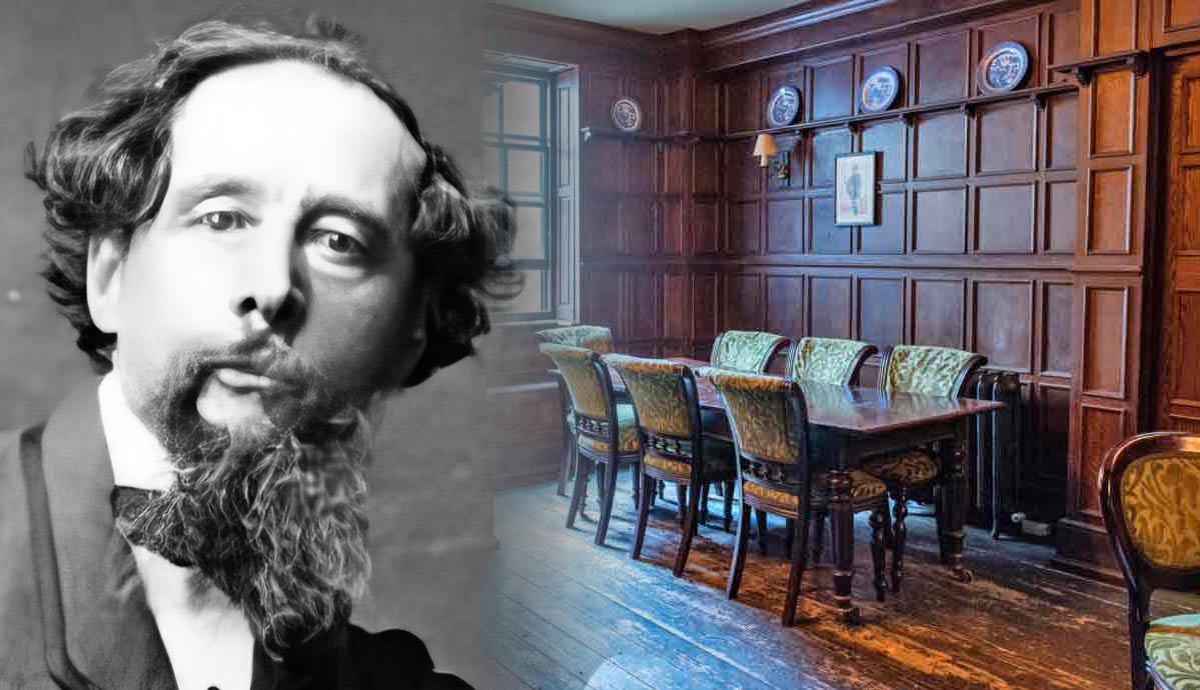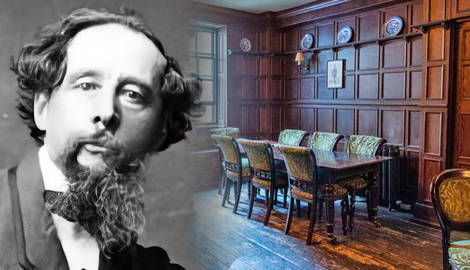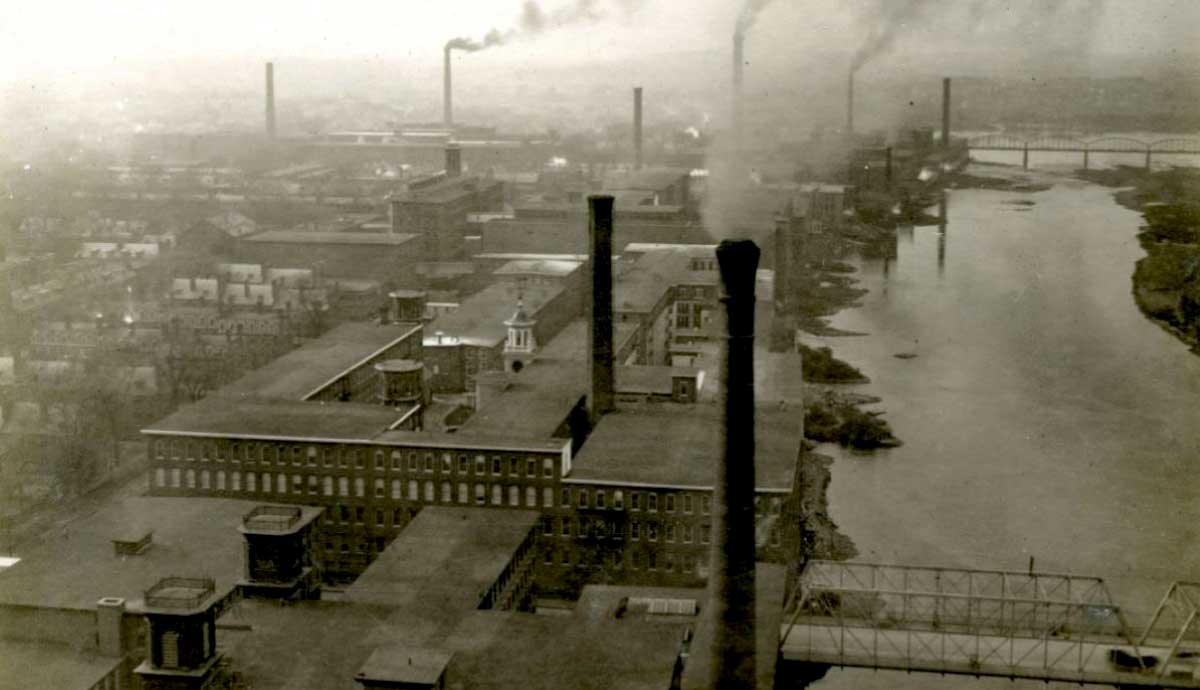
From the cobbled streets of London to the sweeping Kentish Coast, Dickens’s meticulously crafted locations and settings have been intricately woven throughout his works, playing a vital role in shaping his storytelling.
Fortunately, much of Charles Dickens’s literary backdrop remains accessible today. It is still possible to tread in the footsteps of the author and his beloved characters and visit some of the specific locations that inspired his masterpieces.
1. Portsmouth

Dickens was born in Portsmouth, England, in 1812 to John and Elizabeth Dickens. Although he left Portsmouth for London when he was just an infant, Dickens often returned to the bustling coastal city and spoke fondly of his time there.
13 Mile End Terrace
The modest house in which Dickens was born is located at 13 Mile End Terrace. The Georgian terraced house still stands and is now a museum. Its rooms have been restored to recreate the author’s first family home. The museum offers an insight into the very early life of Dickens, as well as the 19th-century Portsmouth in which he lived.
Portsmouth Historic Dockyard

The Dockyard is mentioned in chapter 22 of Dicken’s third novel Nicholas Nickleby. Although highly modernized, Portsmouth Historic Dockyard still stands today. On the docks there is now a vibrant interactive museum, telling of the city’s exciting maritime history and its influences on Dickens’s work.
2. Medway, Kent

When Dickens was just five years old, his father was transferred to the Chatham Dockyards, taking the family with him. During his time in Chatham and the surrounding Medway towns, Dickens would take long walks with his father; the people and places here had a profound effect on his imagination, with many of them appearing in the novels he would go on to write.
Restoration House, Rochester

Rochester served as a huge inspiration for Dickens’s works and is the most featured of all the places in his novels. One of the town’s most notable buildings, the characterful Restoration House, is depicted in Great Expectations. The 16th-century building is the inspiration for the atmospheric Satis House, Miss Havisham’s dilapidated and frozen-in-time mansion.
“Within a quarter of an hour we came to Miss Havisham’s house, which was of old brick, and dismal, and had a great many iron bars to it. Some of the windows had been walled up; of those that remained, all the lower were rustily barred.”
Chapter 8, Great Expectations
The house is now privately owned and has undergone significant renovations throughout the years. It opens its doors to the general public at various times throughout the year for tours of the building and its grounds.
The Six Poor Travelers House
Even without its Dickens connection, this historic building has a fascinating backstory. The house dates back to the 16th century and was established by Richard Watts, a wealthy philanthropist, as an almshouse for impoverished travelers passing through Rochester.
The mansion was immortalized in Dickens’ short story, The Seven Poor Travelers as part of his collection Christmas Stories. Today the house is open as a museum offering an insight into the history of the almshouse and its connection to Dickens.
3. South-East London

Dickens lived a comfortable and relatively privileged life throughout his earliest years and remembers his time in the aforementioned Medway with great fondness. However, following a move to London in 1822, his luck was about to change.
Dickens’s father was notoriously bad at managing his finances, leading the family into debt. Eventually, when Charles was just 12 years old, his father was imprisoned, plunging the family into poverty. This traumatic event had a huge impact on Dickens, and the social injustice and poverty the family would come to face in London would become a recurring theme in many of his novels.
Warren’s Blacking Factory, Villiers Street

Following his father’s imprisonment Dickens was forced to leave school and work in a blacking factory to support his mother and seven brothers and sisters. The grueling conditions at the factory would go on to inform and shape many of his novels and his intricate portrayals of poverty and social injustice. Without this experience of such hardship, we would perhaps not have his greatest works such as Oliver Twist and David Copperfield.
Although the factory itself was destroyed in 1860 to make way for Charing Cross Railway Station, it is still possible to see where it once would have stood on Villiers Street, just off London’s Strand. The street is now home to offices and a myriad of restaurants and wine bars but, on a quiet early Sunday morning with the Thames lapping the nearby shore, it is possible to imagine the young Dickens making his way up the steps to the harrowing conditions of the factory.
Marshalsea Debtors’ Prison, Borough, Southwark

Fortunately, Dickens’s father was released from the debtors’ prison after two months following an inheritance that allowed him to pay his debts. However, his father’s time in prison certainly had a profound effect on the author, and he later set his novel Little Dorrit in and around Marshalsea.
Dickens writes of Amy Dorrit, the titular character, being born and raised in the prison and he goes on to satirize the shortcomings and impossible bureaucracy of the debtors’ prison. The last remaining wall of the prison can be seen on Borough High Street, towards Angel’s Court. On the floor of the alley are paving stones, engraved with quotes from the works of Charles Dickens.
4. Farringdon, Clerkenwell, and Holborn London

Dickens and his family would go on to recover from their initial hardships and the author would grow to have a somewhat conflicted relationship with his home city. On the one hand, he admired the vibrancy and eclecticism of urban life, yet he was not able to separate himself from the poverty, deprivation, and injustice faced by many of its residents.
Dickens would constantly wander the streets of Farringdon North London where he lived from 1837 to 1839 with his wife Catherine and their growing family. At this time Farringdon was a vibrant, urban area with bustling streets lined with both industrial and residential buildings. Dickens would observe the crowded streets and the diverse population of Farringdon from his house on Doughty Street and it was here that he would go on to write Pickwick Papers, Oliver Twist, and Nicholas Nickleby.
48 Doughty Street

Today, Dickens’ Georgian townhouse is preserved as the Charles Dickens Museum, celebrating the life and works of the author. The museum stands as a testament to his legacy and showcases original manuscripts and the author’s personal belongings, giving visitors a fascinating insight into the world he inhabited.
Pear Tree Court
Just down the Farringdon Road (past the Betsy Trotwood pub, named after David Copperfield’s aunt!), is Clerkenwell’s Pear Tree Court. The small courtyard is believed to be where Dickens first saw the pickpocket that inspired the Artful Dodger.
Saffron Hill
Technically part of Holborn, Saffron Hill is just a short stroll from Clerkenwell Road. It’s possible to follow in the footsteps of Oliver Twist where he was led by the Artful Dodger to Field Lane and into Fagin’s lair.
The area at the time was one of the most deprived in London, large families lived in tiny slums where food was sparse, crime was rife and conditions were highly unsanitary. The labyrinthine streets of squalor were demolished in the 1860s but the story lives on through the street names. It is believed during Dickens’ times that the poorest of areas were given attractive names such as Saffron Hill or Lily Place to cover up the sheer deprivation experienced by their inhabitants.
5. Central London

Ye Olde Cheshire Cheese
This historic gem of a pub is situated on Fleet Street, on the edge of the City of London, and has been a favorite haunt of many a famous literary figure over the years. The pub has maintained its old-world charm and atmosphere, with its sawdust-covered floor, wooden barrels, and high-backed church pews. Dickens was a regular customer; enjoying “a good plain meal with good wine” and the pub is mentioned by name in A Tale Of Two Cities.
Newgate Street

Given his earlier experiences of the reform system, it is no surprise that Dickens was absorbed by the squalor and brutal conditions of Newgate Prison with its many public executions. Within Barnaby Rudge, Dickens describes the impact of the harsh conditions of the prison while the trials of Charles Darnay in A Tale of Two Cities and Magwitch in Great Expectations are both said to take place at Newgate.
While Newgate prison has been long since demolished, its legend certainly lives on. The Old Bailey now stands on the site where the prison once stood, but a singular wall in Amen Corner still remains. Perhaps even more chilling is the preservation of the bell which was used to chime before a prisoner’s execution which is housed in nearby Saint Sepulchre Church.
6. Broadstairs, Kent

Dickens first visited the charming coastal village of Broadstairs in 1837. He would go on to frequently return with his family, walking along the cliff tops and socializing with the locals and fellow writers, constantly soaking up inspiration for his stories. The fictional town of Bleakbridge in David Copperfield is said to be based on Broadstairs.
Bleak House
Overlooking the picturesque Viking Bay in Broadstairs, Bleak House (known as Fort House during the 19th century) was a favorite holiday home of Dickens and was where he wrote sections of both Bleak House and David Copperfield.
Betsy Trotwood’s House

While there may be a pub named after the character in London, the real Betsey Trotwood, was named after Mary Pearson Strong, who actually lived in Broadstairs. Dickens and his son often visited Mary where they frequently witnessed her preventing donkeys from passing her cottage — this donkey-chasing behavior is comically mirrored by Betsey in David Copperfield! The cottage is now home to the Dickens House Museum which offers visitors a wealth of memorabilia commemorating his associations with the town.
7. Higham, Kent

Charles Dickens died on June 9, 1870. He had always talked fondly of his time in Kent so it seems fitting that this would be where he would spend his final days.
Gads Hill Place
Gads Hill Place was the only home Dickens ever owned. As a boy, he had admired the country house and vowed that he would, one day, own it himself. He did indeed purchase the property in 1856 and lived there until he died. The house is now a school but can be visited on several weekends throughout the year, from April to October.








